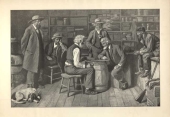The Checker Maven
The World's Most Widely Read Checkers and Draughts Publication
Bob Newell, Editor-in-Chief
Published every Saturday morning in Honolulu, Hawai`i
Noticing missing images? An explanation is here.
Oh My Goodness

We think we've chosen an appropriate title for this month's stroke problem, which at first glance looks as scary as that big snake in the photo above.
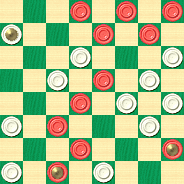
WHITE
White to Play and Win
W:WK5,10,12,14,16,19,20,21,24,29,31:B2,3,4,7,8,15,18,22,26,K28,K30.
Will you be squeezed by the complexity of the problem, or will you slither away successfully? Either way, click on Read More to uncoil the solution.![]()
What Is A Gem?

The definition of a 'gem' problem in checkers is not always clear. We like to think of this in a manner that extends the metaphor: a problem or situation that sparkles and is brilliant in its solution.
Today's installment of our Checker School series presents Dunne's Gem as published in Ben Boland's Famous Positions in the Game of Checkers. Here's the situation:
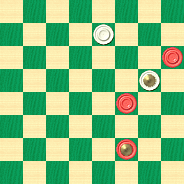
BLACK
Black to Play and Win
B:W26,K17:B21,14,K6.
Now, Black is a man up. What's so special, so gem-like, about this position (if, indeed, anything)?
Work out the solution and then you decide. Is this a true gem or just an ordinary lump of coal? As you might expect there is more here than meets the eye at first glance.
When you're ready, click on Read More for the solution, a sample game, and some notes, quotes, and votes.![]()
Instant Gratification

This month we're giving you not one or two but four speed problems. No, we're not being extra-generous; these problems are of a very easy nature and shouldn't take but an instant to solve.
And, knowing us, you know that therein lies the catch. We're giving you all of ten seconds to solve each problem. How good is your pattern recognition? Can you achieve instant gratification by immediately seeing the solutions, or will you be caught by our unforgiving time clock?
Click on Read More to check your solutions, but we doubt you'll need much help here.
Problem One (extremely easy)
Problem Two (extremely easy)
Problem Three (very easy)
Problem Four (very easy)![]()
Inexhaustible

In this age of computerized checkers, with the strongest programs now likely exceeding the capability of even the top human champions; and with the announced intention of the Chinook project to 'solve' the game completely, we often hear that checkers is exhausted, worn out, and no longer of interest.
Well, in this article we're about to disprove that notion--- as if it needed disproving.
Let's look at a position from Richard Pask's excellent book, Key Themes, which, by the way, we'll be offering here in a free, newly typeset electronic edition sometime in this spring (2006). The theme is "The Sunken Piece on Square 5" and we arrive at the diagram below from 11-15 23-19 9-14 22-17 5-9 17-13 14-18! 19-16 12-19 26-23 19-26 30-5.

BLACK
Black to Play and Draw
B:W32,31,29,28,27,25,24,21,13,5:B15,10,8,7,6,4,3,2,1.
Let us first assure you that the position is indeed a draw. Black may be a man down but the White piece on square 5 is very much out of the action. Mr. Pask, in his book, gives a continuation from published play, resulting in a draw. But deep computer analysis shows that there are other possibilites, and the Black draw be obtained in at least a couple of different and very interesting ways.
We invite you to do your own analysis, and see how you think Black might draw. Then click on Read More for a few different takes on the position. We think you'll be completely convinced that, as far as the human mind is concerned, checkers is anything but old and tired, and is a truly limitless art.![]()
Brian's Bear Claw Still Unsolved

Brian Hinkle's challenging Bearclaw problem remains unsolved, and less than a month is left until we publish the solution. It's a tough nut to crack, but it's also a chance for the real two-fisted checker player to pull off a coup.
So don't pass up this last chance. Click here to see the problem again, and email your solution to Brian as quick as you can!![]()
Better Than First

Take careful note of our fisherman in the picture above. In a tranquil setting, he has a calm, relaxed mind, and he has focused his attention completely on the seemingly simple task of fishing.
But these supposedly easy things can, in their idyllic appearance, mask a great deal of depth and the often unexpected need for substantial skill and experience. Such is the case with today's feature problem, a miniature that will require focus, skill, and calmness of mind to solve.
And, you'll understand the title of our article, Better Than First, when you've found the solution.

BLACK
Black to Play and Win
B:W31,19:BK4,2.
Were you able to solve it? Just click on Read More for the answer, and an explanation of the theme.![]()
Dead-End Duffers
Our electronic republication of Willie Ryan's incomparable Tricks Traps & Shots of the Checkerboard continues this week with two situations which Willie says he has used often to bring down less skilled opponents. Here's what Willie has to say about all this.
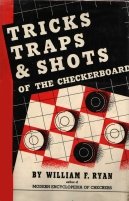
Drummond's Dead End
Among the relatively few pitfalls I have used hundreds of times in my exhibition demonstrations, this old acorn by bumptious John Drummond, a fiery Scotsman with a pronounced talent at draughts, ranks high. Rack up the pieces. Then move: 9-14, 22-18, 5-9, 25-22, 11-16, 29-25, 16-20, 24-19, 8-11, 28-24---A, forming the position shown on the diagram.
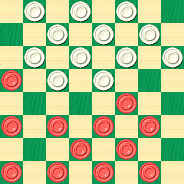
BLACK
Black to Play and Win
B:W32,31,30,27,26,25,24,23,22,21,19,18:B20,14,12,11,10,9,7,6,4,3,2,1.
A---No hope for white after this. The only move to draw is: 21-17, 14-21, 18-15, 11-18, 23-5, 4-8, 22-18, 20-24, 27-20, 8-11, 18-14, 10-17, 26-23, 6-10, 31-26, 10-14, 25-22, 11-16, 22-13, 21-25, 30-21, 14-18, 20-11, 7-16, 23-14, 16-30, etc. Wm. F. Ryan.
Decoy For Duffers
This eight-move plot has led countless novices of the game to a defeat begotten by careless procedure. Let's set up the pieces for play. Now move 10-15, 22-18, 15-22, 25-18, 6-10, 29-25, 10-15; at this point 25-22---A loses, bringing us up to the layout on the diagram.
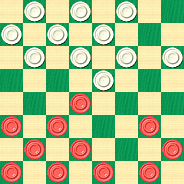
BLACK
Black to Play and Win
B:W32,31,30,28,27,26,24,23,22,21,18:B15,12,11,9,8,7,5,4,3,2,1.
At A, white can play either 26-22 or 18-14 with a firm position in hand.
Editor's Note: Dead-end duffers and charging champions alike can click on Read More to see Willie's solutions to these problems.![]()
Easy or Hard? It All Depends...

Is this month's stroke problem an easy one, a hard one, or something in-between?
We guess it all depends: on your mood or degree of alertness on any given day; on your overall checker skill; on your ability to visualize complex situations; or on a whole host of other possible factors, including, sometimes, just taking a lucky guess.
So we won't presume to judge. We'll let you make the call.

WHITE
White to Play and Win
W:WK2,K7,K11,15,16,18,19,23,26:B6,9,12,K13,K14,17,K20,25,27,28.
How did you do? Easy or hard? Well, one thing we know is easy: that's clicking on Read More to check your solution.![]()
Cashing In On The Win

Earlier, we presented a series of lessons on man-down draws. Today, we'll extend that series by showing two examples on winning a won game and one more on pulling off a man-down draw.
It's more than a little interesting and instructive to look at man-up positions that ought to be a win, but aren't all that easy to carry out. Here's the first one, credited to E. McMillan. Black is ahead in numbers, but has three single men who haven't moved very far, while White has one king and may soon have another.
WHITE

BLACK
Black to Play and Win
B:WK10,8:B12,9,2.
Now, let's look at a position put forth long ago by the legendary Joshua Sturges. Here we're to draw with a man down. Note that some key elements are in place: Black, though inferior in numbers, has two kings to White's one, and the White men are on the edge of the board.
WHITE
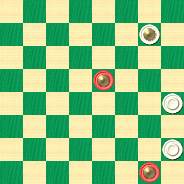
BLACK
Black to Play and Draw
B:WK25,13,5:BK18,K1.
In our final example, Black is ahead in the piece count but has one king against White's two, and White seems to have chances at obtaining Payne's Single Corner Draw.
C. ADAMSON
WHITE
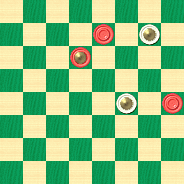
BLACK
Black to Play and Win
B:WK25,K14:B26,K23,13.
After you've worked through these problems, click on Read More for Ben Boland's detailed solutions, example games, and copious notes.![]()
A Checker Author, Too

Fred Reinfeld is a member of the United States Chess Hall of Fame, and quite deservedly so. As a champion player and prolific writer and teacher, his gift for turning complexity into comprehensibility has brought chess lore and learning to millions of players over the years.
What is less well known is that Mr. Reinfeld, who passed away at only age 54, wrote on many other subjects; he was a checker author, and, alas, has gotten little recognition for his single work, How to Win at Checkers (which has appeared in various other forms and titles but is essentially the same item). That's a shame, as this book, still in print in an inexpensive softcover edition, provides much worthy material for beginning to lower-intermediate players (see our Book Reviews, linked in the right-hand column). If you don't have this book, you really ought to get it.
The book does, however, have a couple of rough spots (rather few, as it turns out), and today we're inviting you to work through them and gain a little of recognition for yourself (even if only you will ever know). Let's start with the easy one first, which arises from the Denny opening.
Situation One
| 10-14 | 24-19 |
| 11-16 | 28-24 |
| 16-20 | 19-15 |
| 9-13 | 23-19 |
| 7-10 | 32-28 |
| 14-18 | 21-17 |
Here White should have played 26-23, which maintains a very slight advantage. But now watch Black take advantage of White's error:
| 10-14 | 17-10 |
| 13-17 | 22-13 |
| 18-23 | 27-18 |
| 20-27 | 31-24 |
| 8-11 | 15-8 |
| 6-31 |
BLACK

WHITE
White to Play, Black Wins
W:W8,13,19,24,25,28,29,30:B1,2,3,4,5,12,K31.
Mr. Reinfeld concludes at this point, "Black wins. He will win the man on 8, and he has a King." While it turns out that Black indeed does win, it may not be as obvious as Mr. Reinfeld implies, at least to the eyes of a non-expert player. In fact, a beginner might attempt the following sequence:
| 24-20 | 4-11 |
| 30-26 |
which swaps off the king and maintains material equality, or so it seems.
Your task in this position is twofold: (a) show why trading off the king in this manner loses; and (b) from Diagram 1, demonstrate the Black win. Neither of these assignments are all that hard.
Situation Two
Here's another Denny opening:
| 10-14 | 22-18 |
| 11-16 | 25-22 |
| 16-20 | 24-19 |
| 8-11 | 19-15 |
| 4-8 | 22-17 |
| 12-16 | 17-10 |
| 7-14 | 29-25 |
| 3-7 |
BLACK

WHITE
White to Play and Win
W:W15,18,21,23,25,26,27,28,30,31,32:B1,2,5,6,7,8,9,11,14,16,20.
| ... | 15-10 |
| 6-29 | 30-25 |
| 29-22 | 26-3 |
| 8-12 | 3-8 |
WHITE
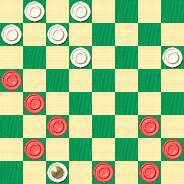
BLACK
Black to Play and Draw
B:W32,31,28,27,23,21,K3:B20,16,11,9,8,5,2,1.
and now Mr. Reinfeld tells us, "White wins. His King will prove too strong for the Black men."
But the problem with this is that White, despite the spectacular fireworks, is a man down! So we now come to a rather difficult threefold assignment: (a) show that the position in Diagram 2B is a draw; (b) show that, after 3-7 above, Diagram 2A, White actually does win, but not with 15-10; and (c) in the runup to Diagram 2A , find Black's losing move and correct it.
And if you really want some respect, show that 2-7 instead of 3-7 still loses (we haven't included the solution; you're on your own)[1].
We've probably outlined several days of work, but when you're ready, click on Read More for some potential solutions.![]()
Fred Reinfeld's photo is used with the kind permission of his son, cellist and bow maker Don Reinfeld.
[1] 12-1/2 years after publication we revisited this analysis with the latest KingsRow computer engine, and found the position is indeed a draw after 2-7! Congratulations Mr. Reinfeld, it's to you that our respect goes.
[Read More]The Checker Maven is produced at editorial offices in Honolulu, Hawai`i, as a completely non-commercial public service from which no income is obtained or sought. Original material is Copyright © 2004-2025 Avi Gobbler Publishing. Other material is public domain, AI generated, as attributed, or licensed under CC1, CC2,CC3 or CC4. Information presented on this site is offered as-is, at no cost, and bears no express or implied warranty as to accuracy or usability. You agree that you use such information entirely at your own risk. No liabilities of any kind under any legal theory whatsoever are accepted. The Checker Maven is dedicated to the memory of Mr. Bob Newell, Sr.

